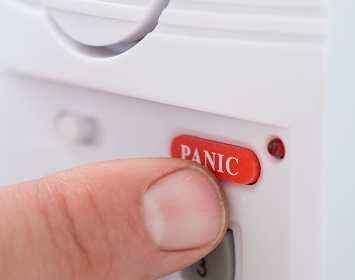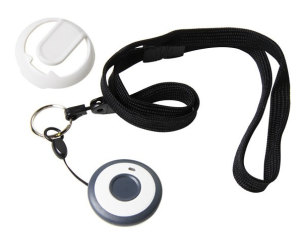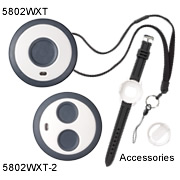Every business owner wants to provide a safe environment for employees and customers. With just about any business there is a chance that an angry or unstable customer, disgruntled employee, someone with a mental illness or a robber will cause or threaten violence in the establishment. Installation of a panic button is a great way to potentially mitigate this danger.
Every business should evaluate the level of risk and vulnerability in their particular establishment and determine if a panic button is needed.
 What is a Panic Button?
What is a Panic Button?
A panic button is a strategically placed or hidden button that automatically alerts police to an emergency situation. These buttons are small and usually placed in a discreet location, like just under the lip of a desk or retail counter. It’s important to place buttons in locations where employees will likely be at the time of a situation. When a robber yells “freeze” an employee should be able to quickly hit the button without anyone noticing. On duty police in the area will be dispatched to your location immediately.
Should A Panic Button Be Silent?
The next question to ask is if your business should have silent panic button or one that sounds an alarm. Do you want a culprit to hear the siren and potentially try to make a run for it? There is a risk that this might upset the perpetrator and cause them to lash out or inflict immediate violence, or it could encourage them to leave the premises. Is it safer to have police arrive unexpectedly and catch the criminal off guard? This could potentially result in a hostage situation.
It’s critical that each business or institution evaluate whether a silent alarm or audible siren makes the most sense. If there is a perpetrator on a school campus or industrial complex, it might make more sense to have an audible siren that warns others of a potential danger. A retail bank or convenient store in which most of the people on staff will be face to face with the perpetrator, a silent alarm could potentially avoid further exasperating the situation. Ultimately, deciding between a siren and silent panic button depends on the business and potential risk scenarios at hand.
Do Office Buildings Need Panic Buttons?
There are many service businesses that rarely ever have customers show up at their location. A front desk receptionist armed with a panic button is a great first line of defense. Although there is a much lower risk of robbery, these businesses still need to worry about disgruntled employees, angry customers and people with mental illness.
Even in a rural area, it’s not unheard of to have an angry customer show up demanding money or that they speak with the CEO. Some people just can’t be reasoned with when their blood is boiling and a panic button can help quickly defuse a dangerous situation.
Can Panic Buttons Protect Against Disgruntled Employees?
Small organizations in which everyone knows each other and has a good working relationship are less likely to encounter dangerous scenarios. If you have 10 or 15 long-term, happy employees at a small office or warehouse facility, there’s probably no need for a panic button. The larger an organization gets, the greater the odds someone will be disgruntled. Why not arm a front desk receptionists with a button that can be pressed in the case of an emergency?
Firing an employee is never easy. People have families, children and mortgages to pay. The vast majority of people take a firing or layoff in stride. Unbeknownst to the company, an employee may be on their last straw or there may be an undiscovered mental illness at hand. Your first line of defense should be an access control system that prevents ex-employees from reentering the building. A few strategically placed panic buttons are a second line of defense if an employee ever returns with violent intentions.
Where Should I Place Panic Buttons?
Anyone that sits on the front lines of a business should have panic button, such as employees at a customer counter or reception area. It’s best to place panic buttons within reach, but out of site, so the button can be pushed discretely. It’s also a good idea for people in a back office to have access to a panic button, who may be able to hear and react to a dangerous situation before being confronted.
Panic Buttons for Schools and Hospitals
More and more schools are adopting panic buttons in classrooms to increase response times in the event of a school shooting. A panic button can help speed up lockdown procedures, issue alerts to staff, initiate emergency protocol and contact emergency responders. The faster police arrive, the better. The same goes for hospitals, where the lives of nurses and patients are at hand. Security Alarm Corporation offers affordable panic button solutions, sometimes even as low as $300.
3.7% of the general U.S. population perpetrates an act of violence every year. Although the likelihood of encountering a violent situation is small, especially in our Southern Illinois communities, it’s important to plan for the worst and hope for the best. Each business needs to evaluate the crime trends in their area and the specific risks associated with their business. Contact us if you’d like to learn more about panic buttons options or would like help determining if a panic button is the right choice for your business.
DIY Wireless Panic Button System
 Includes:
Includes:
(1) Wireless Controller (1) Cellular Communicator
(2) Wireless Panic Buttons (1) All Programming
(1) Installation Tech Support
Equipment & Programming Cost: $400.00 | Panic Alarm Monitoring: $31/month (12 month agreement) | Additional Panic Buttons: $75.00/each
Call or Contact us for more information or to see if this system is right for you.
Due to licensing laws we can only provide services in the following state: Illinois, Indiana, Kansas, Kentucky, Missouri, Nebraska, New Hampshire, North Dakota, Ohio, Pennsylvania, South Dakota, Vermont & Wisconsin.

More information on Panic Buttons:
